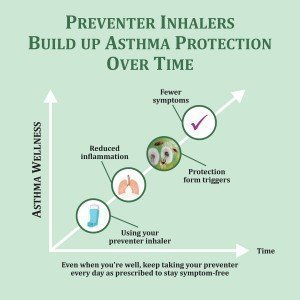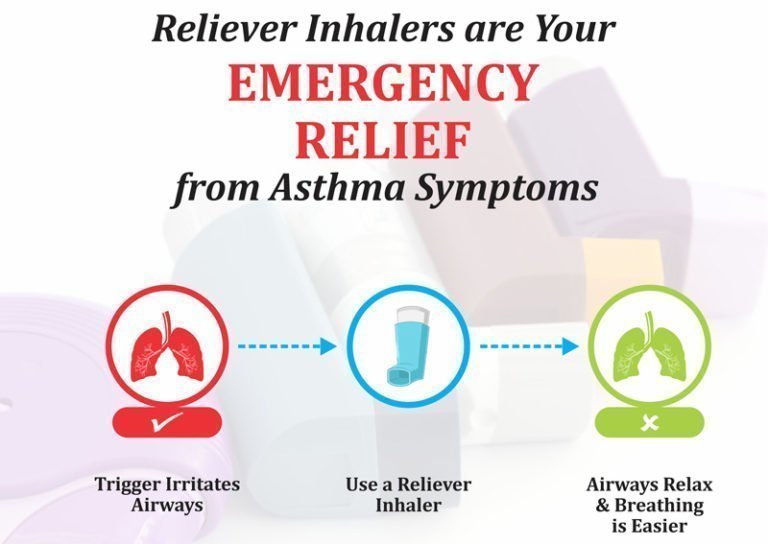
Asthma Treatment
Understanding Asthma Control
Asthma control refers to the ability to manage symptoms effectively, minimize disruptions to daily life, and prevent severe exacerbations. Successful asthma control relies on early diagnosis, adherence to treatment, and regular monitoring. The goals of asthma treatment include:
- Reducing the frequency and severity of symptoms.
- Preventing asthma attacks.
- Maintaining normal lung function.
- Enabling children to participate in physical activities without limitations.

Key Components of Asthma Treatment
1. Asthma Medicines
There are two type of medicines used for treatment of asthma:
- Preventers: these medicines reduce and control the swelling inside the airways. These should be used daily. Inhaled steroids are the most effective preventers. These medications reduce inflammation in the airways, making them less sensitive to triggers. Regular use of inhaled steroids helps control chronic symptoms and prevents flare-ups. Other common preventive medicines used for treatment of asthma include long acting beta agonist bracket LABA or Montelukast.
- Relievers: These medicines relieve bronchospasm and should be only used when the child has symptoms. Salbutamol or levo-salbutamol are the most effective relievers.
2. Devices
The key to successful management of asthma is a proper delivery of medicine to the airways. In addition as the treatment is long term the medicine should not lead to any side effects to the child. To achieve this the most important factor is the device used to deliver the medicine and its technique. Inhalers are devices used to deliver medication directly to the lungs. Metered Dose Inhalers and Dry Powder inhalers are the main devices used in treatment of asthma. Metered dose inhalers are the most commonly used in children.
Inhalers should always be used with SPACERS in children and adolescents. Spacers have many advantages like
- Spacers increases the amount of the medicine reaching the lungs and hence would make inhalers more effective.
- Using a spacer would reduce the amount of medicine deposited in the mouth and hence reduce the amount of medicine absorbed in the body.
- There is no coordination required in pressing the inhaler and taking a breath.
Teaching children and their caregivers the correct inhaler technique is crucial for ensuring medication effectiveness.
3. Allergy Management
Since allergies often trigger asthma symptoms, identifying and managing allergens is a vital part of treatment. Strategies include:
- Avoiding known triggers such as pollen, dust mites, and pet dander.
- Considering allergy medications or immunotherapy when necessary.
4. Asthma Action Plan
An asthma action plan is a personalized document that outlines:
- Daily management strategies.
- Steps to take during worsening symptoms.
- Emergency actions in case of a severe attack.
This plan helps caregivers and children stay prepared and respond promptly to changes in asthma control.
5. Regular Follow-Up
Routine check-ups with a pediatric pulmonologist ensure that the treatment plan remains effective. Monitoring includes assessing symptom control, adjusting medications, and reviewing inhaler techniques.
Importance of Adherence to Treatment
Consistency is key to achieving and maintaining asthma control. Children and caregivers must adhere to prescribed treatments, even when symptoms improve, to prevent relapses and complications. Education about the importance of regular medication use empowers families to manage asthma effectively.
Asthma control in children requires a comprehensive approach that combines inhaled steroids, proper inhaler use, allergy management, and regular follow-ups. Pediatric pulmonologists play a crucial role in guiding families through the journey of managing asthma, ensuring children can live active and healthy lives.
Conclusion
Frequently Asked Questions (FAQs)
1. What is the role of inhaled steroids in asthma treatment?
Inhaled steroids reduce airway inflammation, making them the foundation of long-term asthma control. They help prevent symptoms and reduce the risk of severe attacks.
2. How do I know if my child's asthma is well-controlled?
Asthma is well-controlled if your child experiences minimal symptoms, can sleep through the night without interruptions, and participates in activities without limitations. Regular follow-ups with a doctor help confirm control.
3. Are inhalers safe for children?
Yes, inhalers are safe when used correctly. Steroids used in inhalers are very safe since only a very minute amount enters the body. The common side effects observed with oral steroids are almost absent with inhaled steroids. Inhaled steroids have been used for years without any side effects.
4. Can regular use of Inhaled steroids lead to reduced height in children?
It has been shown that children on long term steroids can have 1 cm to 1.2 cm less height in long term. BUT it should be remembered that if asthma remains uncontrolled then the reduction in height can be much more because of the disease itself.
5. Are Inhalers very strong and are used as the last resort therapy?
The medicine used in syrups and inhalers is almost the same. Hence it means that it’s just a better way of giving the same medicine. Inhalers are the best method of giving the medicine in children with asthma.
6. Are Inhalers used in asthma treatment habit forming?
The medicine used in the inhalers is NOT habit forming. Inflammation in children with asthma sometimes take a longer time to resolve and can reappear. Hence, on early withdrawal of inhalers symptoms can reappear. This has lead to a misconception that inhalers are habit forming. Inhalers should be used for prescribed duration and should not be discontinued without doctor’s prescription.
7. Are inhalers better than oral syrups or tablets?
Inhalers are much better than oral medicines in many ways. Inhaled medicines directly reach the airways leading to better and quicker relief in the symptoms. The amount of medicine in inhalers is quite less as compared to syrups and tablets. The medicines used in inhalers are retained in the airways and does not get absorbed in the body theraby reducing side effects.



